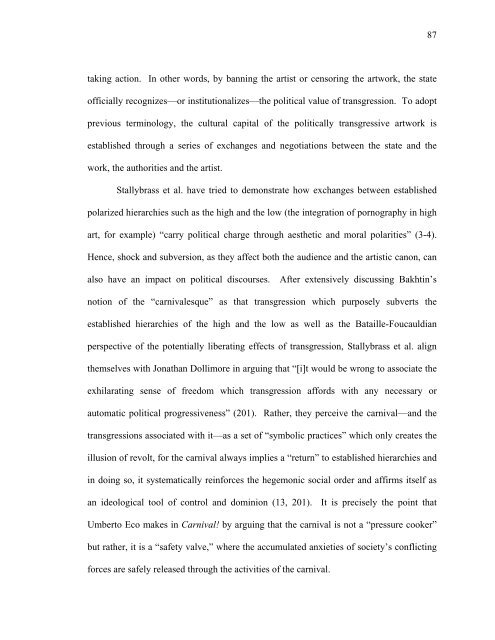Untitled - Sexey's School Moodle
Untitled - Sexey's School Moodle
Untitled - Sexey's School Moodle
You also want an ePaper? Increase the reach of your titles
YUMPU automatically turns print PDFs into web optimized ePapers that Google loves.
taking action. In other words, by banning the artist or censoring the artwork, the state<br />
officially recognizes—or institutionalizes—the political value of transgression. To adopt<br />
previous terminology, the cultural capital of the politically transgressive artwork is<br />
established through a series of exchanges and negotiations between the state and the<br />
work, the authorities and the artist.<br />
Stallybrass et al. have tried to demonstrate how exchanges between established<br />
polarized hierarchies such as the high and the low (the integration of pornography in high<br />
art, for example) “carry political charge through aesthetic and moral polarities” (3-4).<br />
Hence, shock and subversion, as they affect both the audience and the artistic canon, can<br />
also have an impact on political discourses. After extensively discussing Bakhtin’s<br />
notion of the “carnivalesque” as that transgression which purposely subverts the<br />
established hierarchies of the high and the low as well as the Bataille-Foucauldian<br />
perspective of the potentially liberating effects of transgression, Stallybrass et al. align<br />
themselves with Jonathan Dollimore in arguing that “[i]t would be wrong to associate the<br />
exhilarating sense of freedom which transgression affords with any necessary or<br />
automatic political progressiveness” (201). Rather, they perceive the carnival—and the<br />
transgressions associated with it—as a set of “symbolic practices” which only creates the<br />
illusion of revolt, for the carnival always implies a “return” to established hierarchies and<br />
in doing so, it systematically reinforces the hegemonic social order and affirms itself as<br />
an ideological tool of control and dominion (13, 201). It is precisely the point that<br />
Umberto Eco makes in Carnival! by arguing that the carnival is not a “pressure cooker”<br />
but rather, it is a “safety valve,” where the accumulated anxieties of society’s conflicting<br />
forces are safely released through the activities of the carnival.<br />
87



